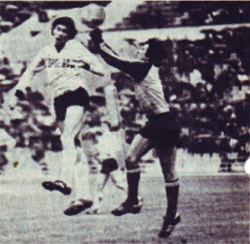The Cup final opposed Milan to Sampdoria. To a point, both finalists were a bit unexpected: neither team was all that great, compared to some others. Sampdoria never reached a final before; Milan played – and won – the Cup final in 1977 for the last time. After that… it was bribing scandal, penalties, second division, the club was just coming back from its terrible years and was not yet great shape. Victory was very important for either team, it was a close call, so it was laughable even to suggest a favourite, Milan had history on his side and that was the most advantage one can thing of. Sampdoria made very important step toward winning the Cup in Milan, where they won 1-0. In the second leg, at home, they prevailed 2-1 and it was fantastic to receive the Cup in front of their excited and delirious fans.
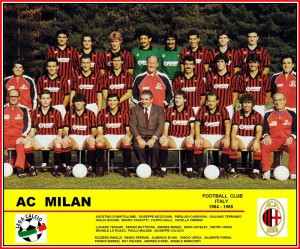
Milan lost – they were ascending, no doubt, but lost minimally their first attempt at winning a trophy after the years of decline. But their time did not come yet, and the squad betrays why: not a bad team, but unfinished. Perhaps their imports made the tiny difference: Ray Wilkins was getting old, Mark Hateley, for all his good playing, was hardly a top-class star. In terms of winning… well, neither of them was a winner in England. No wonder the seeds of the future great Milan were only Maldini and Baresi – even Casiraghi became top Italian goalkeeper and national team choice when playing for another club. Too bad Milan lost, but it was early for them to win.
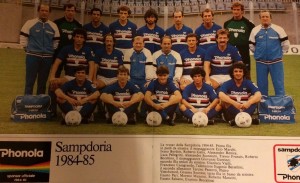
Sampdoria wan the Cup, instantly becoming a legend: it was first ever trophy for the club. It was also a completion of extraordinary season: given who played in Italy at the moment, both winners of the season were underdogs. First title for Verona, first Cup for Sampdoria, first ever trophy for both clubs, won in that particular time, when ‘reason’ declares that other clubs were natural winners. Hard to believe today, but at the time Sampdoria was still considered relatively small and insignificant club, similar to Verona, not the likes of Juventus, Inter, Milan, even Roma. Even at home Sampdoria was still the second club – even in decline, Genoa was the bigger club, not only the older, but also very successful. Yes, Genoa played big role in very distant past, but Sampdoria was still the new kid in the block, relative newcomer even to first division football. Their ascend was very recent and perhaps many could not take seriously, given traditional insignificance. But the boys won and they were not just some nobodies – even compared to Verona, Sampdoria looked mightier: Graeme Souness, Trevor Francis, Ivano Bordon, Pietro Vierchowod, highly talented future great stars Mancini and Vialli. It was not a squad assembled just for one-two great years – it was a team with looking at the future, long term vision. A victory not so much confirmed Sampdoria’s good built, but mostly a victory spurring the process of building: confirming the road taken was right, giving one more stepping stone, fueling ambition and confidence. Sampdoria needed victory more than Milan, that was clear, and the hungrier team got the Cup. Wonderful! Double wonderful – Verona and Sampdoria getting ahead of Platini’s Juventus, Maradona’s Napoli, Zico’s Udinese, Socrates’ Fiorentina, Baresi’s Milan, Rummenigge’s Inter , Falcao’s Roma. Must be said even one more time: the underdogs won everything in the season of the greatest in the world playing all in Italy.
Italy I Division
First Division. This season should have a special place in the Italian football history, for it ended against odds and reason – with the wealth of players at hand, one expects an exciting battle between Platini’s Juventus, Maradona’s Napoli, Socrates’ Fiorentina, Inter, Milan, Roma, and perhaps even Zico’s Udinese, but instead teams with not-so-shiny stars won this year. How great the game was is one thing – and despite the world’s greatest strikers, it was still typical Italian season, laced with ties (Atalanta ended with 18) and low scoring (Juventus scored most – 48 goals; Lazio – the least, 16) – but the oddity of first-time winners of both championship and Cup is another. Entirely unexpected finish, which can be seen in two ways: the competition was so fierce, that even smaller clubs were at par with the greats or the greatest stars underperformed and were not worthy of their salaries. Of course, excuses can be piled up and reasons found, and simplest wisdom of the game can be reinforced – those in best form and biggest ambitions prevailed. Still, the winners were strange compared to the losers, some of which were not even among the leading teams of the season, but somewhere down the table. Even for the fact that both trophies were won by teams never winning anything before was extraordinary and remarkable, especially in Italy.
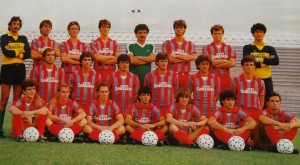
Cremonese finished last – an outsider with 15 points and quite expected so.

Lazio – the other outsider, ending also with 15 points, but placed above Cremonese on head-to-head record. The dark period was still going on, so another relegation. With Michael Laudrup in their squad, they managed to score just 16 goals… 15th and out.
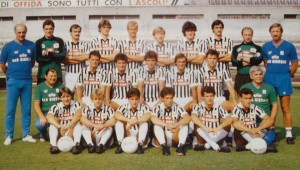
Ascoli – did what they could, but they were expected to finish low and 14th place was no surprise. 22 points. Relegated.
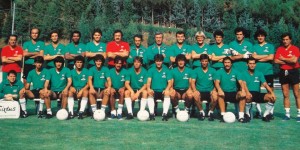
Avellino survived – 13th with 25 points.
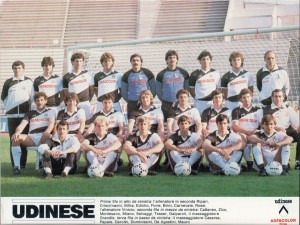
Udinese – 12th with 25 points. Head-to-head record placed then behind Como. Ordinary, such lowly position would not be surprising, but that was a team led by Zico and Edinho, and had a few more decent players. Disappointing season, rising the question why spending big money on big foreign names.

Como – 11th with 25 points. No surprise, really. With aging Hansi Muller they managed to finish ahead Udinese and Zico. Then again, Zico was aging as well. Como never lost a game at home this season, sharing this record with Inter.
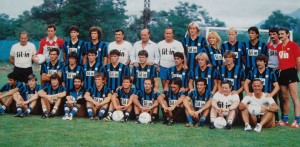
Atalanta – 10th with 28 points. Quite expected, given the circumstances – they had no superstar, only stars. Well… Stromberg and Larsson hardly come to mind in a league saturated with great names. The woman in the picture looks like Swede, but she was not a player.

And here comes… Fiorentina finished 9th with 29 points. They won 8 games and lost 9. Socrates, Passarella, Antognoni, Gentile, Pulici, Oriali, Pecci, Galli… a champion contender, not a inferior mid-table team. Yet, they lost more games than they won.
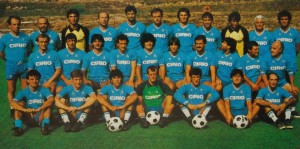
Napoli – 8th with 33 points. Maradona smiles on the photo, but… let say Napoli was not ready. Let say the magic formula was not found yet, that Bertoni was no Careca. True. Maradona finished above Zico, Socrates, and Passarella. True. He also finished way bellow Elkjaer-Larsen and Schachner. True.
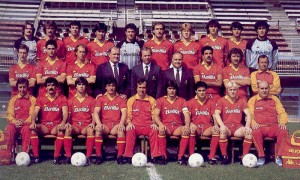
Roma – 7th with 34 points. Top row from left: Malgioglio, Maldera, Nela, Ancelotti, Tancredi, Graziani, Chierico, D.Bonetti, Giannini, ?
Middle row: Lucci, Righetti, Falcao, ?, Eriksson, Alicicco, Cerezo, Pruzzo, ?
Sitting: ?, Oddi, ?, Antonelli, Clagluna, B.Conti, Iorio, Buriani, G.Rossi.
Roma was already beyond its peak, so there was excusable reason for their relatively low position. Eriksson was still new to the club and Italian football in general and the squad he had at hand was aging (Maldera, Graziani, Tancredi, Pruzzo). Di Bartolomei was already lost. Objectively speaking, Roma was going downhill – perhaps the only team which can be excused.
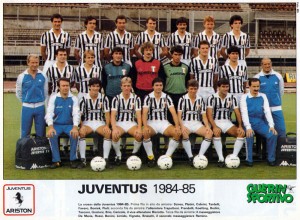
Juventus – 5th with 36 points. Excuses do not work in their case: yes, they concentrated on European level, but great teams prove their greatness by winning on more than one front. And Juventus was the strongest Italian club for years, so ending the season with no domestic trophy, not even coming close to winning one is pretty much a failure, if not outright shame.
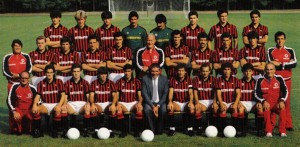
Milan – 5th with 36 points. Nothing special, but it could be looked in positive light: Milan was recovering from its terrible period and coming back to its rightful place among the leaders. Not a great squad yet, but going up and firmly on the road of building a really strong team.
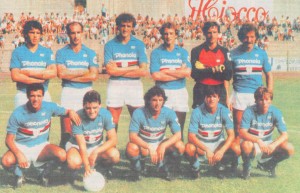
Sampdoria – 4th with 37 points. The greatest period of the club started – they became one of the leading clubs and were going to stay. Crouching from left: Roberto Galia, Roberto Mancini, Evaristo Beccalossi, Fausto Pari, Moreno Mannini.
Standing: Luca Pellegrini, Allesandro Scanziani, Allesandron Renica, Trevor Francis, Ivano Bordon, Graeme Souness.
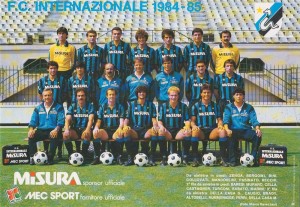
Inter – 3rd with 38 points. Bronze is not satisfying colour for Inter, but there was something going on for more than 10 years now: Inter was somehow unable to make a golden team. Always somewhat incomplete, with few questionable positions, slightly imbalanced. Among the leaders, but hardly a winner.
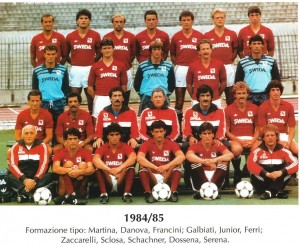
Torino – 2nd with 39 points. Somewhat against the odds finished 2nd best – Torino’s best years were clearly over and the team was going into decline and worse. This was perhaps the last spark of them. The squad was still decent, but let face it: not so many strong players and Schachner was hardly on compatible level with Socrates, Zico, Maradona, Rummenigge and others world-class stars. Of course, a great season of the underdog is appreciable, but it was just a single season.
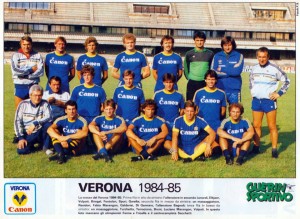
Verona – champions with 43 points from 15 wins, 13 ties, only 2 lost games, 42-19 goal-difference. This was a big bang: highly unusual victory of a small team, which not only never won anything, but very rarely ending in the upper half of the league. Given what wealth of talent the other clubs had, Verona should not have even come close to a title – a strong season should have been something like 6-8 place. Very likely they benefited from the mistakes, distractions, and other temporary weaknesses of the others, but Verona played as a tight outfit, fighting hard, in perfect form. Hardly an innovative team – traditional iron Italian defense was their approach, adapted to the reality of 1980s: great condition, back-to-back 90 minutes running, strong and constant pressure on the opposition from the first minute to the last. Going for a tie and taking it from there – and it worked just fine. They were almost unbeatable and managed to extract more wins than anybody. They had the perfect players for such physical and tough approach: Hans-Peter Briegel and Preben Elkjaer-Larsen – big men, sturdy and spirited fighters, playing no-nosense football, quick to spot and use every opportunity, however small. Fearless players, standing their ground against anyone. Both were at their peaks and really flourished in Verona, aided by similarly tough guys – not the biggest stars, but very dependable. The mix helped the Italian players as well – eventually, Fanna and Tricella were included in the national team. Di Gennaro, Galderisi, Fontolan, Marangon became highly respected players as well. Verona proved once again that well-made and spirited squad of hard-working second-raters could be successful and beat fancy teams, which may be more talented, but were vulnerable to shaky form, mood, lack of a player or two for some position. Verona was a true team of the 1980s: nothing flashy and breathtaking, but very efficient and prevailing at the end. Rolling over opponents, not outplaying them. It was not pleasant football, but fitted the philosophy of the 80s: big deal what dazzling moves Maradona, Platini, Zico and Socrates can do, only the result counts. And when the result at the final whistle is 1-0, the prove is in plain sight: the loser got applause, the winner – the title. Verona was wonderful victor: an underdog leaving in the dust the favourites against any odds and dreams. Yet, it was also clear that this was one-time wonder: Verona did not the squad, the talent, the money for establishing long domination. One can beat the best in the world, but once in a blue moon, not every time, not for long. It was great to see such winners of championship, which arguably had concentrated the most world-class talent. It was also great to see such a small and historically insignificant club winning – after all, nobody even imagined possible ‘conflict of interests”: that a day will come when a second club from Verona will go up. So, it was just ‘Verona’ at the time and perhaps even in Italy most people were unaware that the name was ‘Hellas Verona’. Many years after this had to be changed, for Chievo climbed up and ‘Verona’ was simply confusing. Thus, it was a victory of ‘Verona’ in actual time, but today it is victory of Hellas Verona. Well, a victory to last in memory.
Italy II Division
Second Division – Serie B. Three teams promoted, 4 – relegated. Quite dramatic championship – 5 teams aimed at promotion. At the bottom – 2 outsiders and almost half the league desperately trying to avoid the other 2 relegation spots. At the end, corruption case decided one of them.
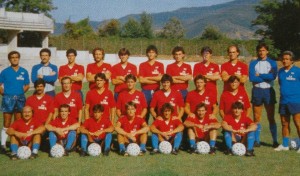
Taranto – last and out with 23 points.
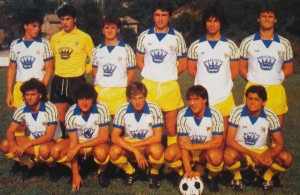
Parma – 19th with 26 points. Relegated.
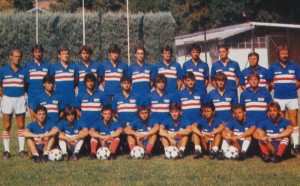
Varese – 18th with 33 points. Going down as well.
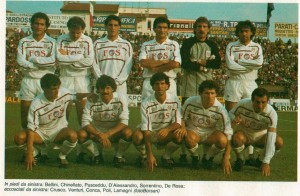
Cagliari – 17th with 34 points. Their Peruvian player Uribe was perhaps smitten – from playing at World Cup finals to Third Division, what misfortune. Alas, the story had a happy end: Padova was found guilty of corruption and expelled. The final table stayed intact, but Cagliari survived.
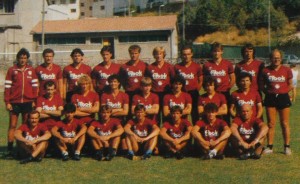
Arezzo – lucky 16th with 35 points.
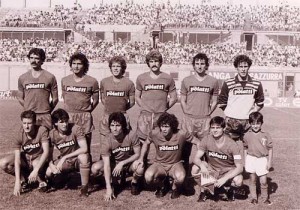
Catania – 15th with 35 points.

Padova – 14th with 35 points. Relegation scared half the league and Padova took some ‘extraordinary measures’ to save itself. This measures were corrupt, they were found guilty and expelled to Third Division to the delight of Cagliari.

Campobasso – 13th with 36 points.
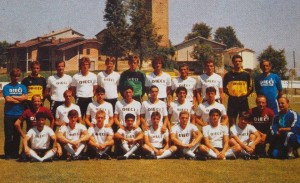
Cesena – 12th with 36 points.
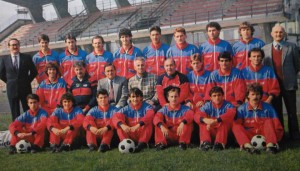
Sambenedettese – 11th with 36 points.

Monza – 10th with 36 points.
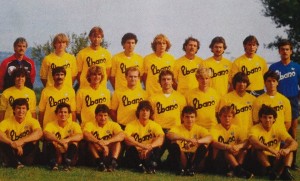
Bologna – 9th with 36 points. Unusual colours, but that was the only remarkable thing about them this season.
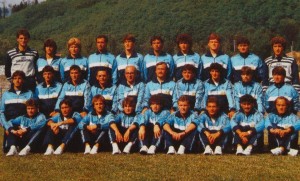
Empoli – 8th with 37 points.
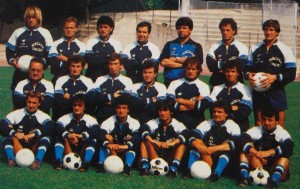
Pescara – 7th with 38 points.

Genoa – 6th with 40 points. A vast gap between them and those running for promotion.

Triestina – 5th with 47 points. Fought bravely and lost at the end.
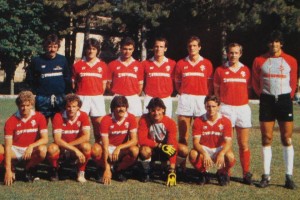
Perugia – 4th with 48 points. They lost promotion by very little, but their record deserves a note, so unusual it was. Perugia lost only match this season – the next best had 4 losses. However, they managed to tie 26 games! They tied 26 out of 38 played games – this was fantastic even for Italy. Makes one craving for the perfect record – 38 games, 38 ties. But this ties did not serve Perugia at the end – they came 1 point short of promotion. 1 tie – 1 point…
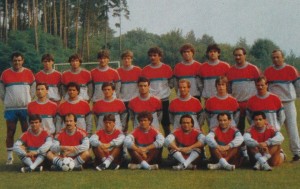
Bari clinched 3rd place with 49 points and was promoted. Hazardous approach worked for them – they lost most games among the top teams (7), but also won most (18) and that propelled them back to top league football.
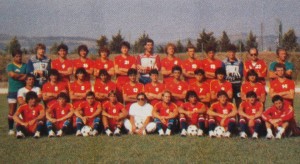
Lecce – second with 50 points. Happily promoted, so no matter they finished second.
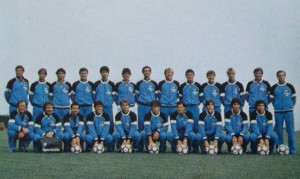
Pisa clinched the title on better goal-difference, for they also finished with 50 points. 17 wins, 16 ties, 5 losses, 52-27. It was good to win the championship and much better to go up, especially after grueling season. And what relief the victory had been for Wim Kift – only a few years back, he was the top scorer of Europe, and now… second division. And not able even to outscore the unknown players there: 3rd with 15 goals. Someone called Bivi scored 20 for Bari.
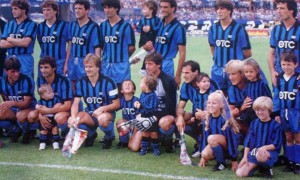
One more look at the happy champions of Serie B.
Italy III Division Group B
Third Division. Girone B. If there was no problem with promotion or relegation, then there was no play-off: the champion of the league was decided by goal-difference.
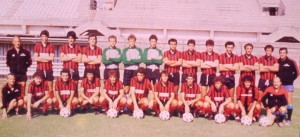
Nocerina – last and relegated with 23 points.
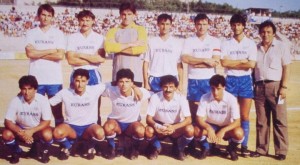
Akragas – 17th with 24 points.
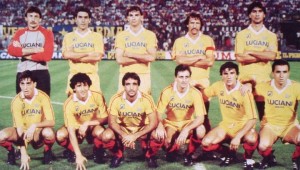
Francavilla – 16th with 30 points. Relegated.

Reggina – 15th with 31 points. Relegated om head-to-head record against Cavese.
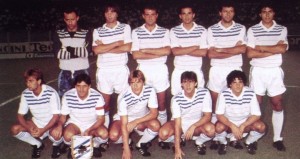
Cavese – lucky 14th with 31 points.
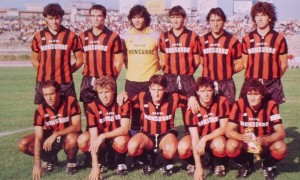
Foggia – 13th with 32 points.
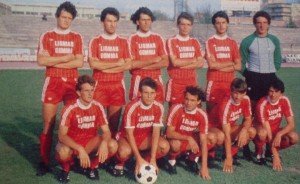
Barletta – 12th with 32 points.
![beneventoakragas8485[1]](/wp-content/uploads/2020/02/beneventoakragas84851-300x202.jpg)
Benevento – 11th with 32 points. Record number of ties this season – 20. 10 at home and 10 away.
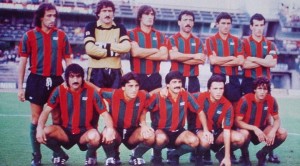
Ternana – 10th with 32 points.
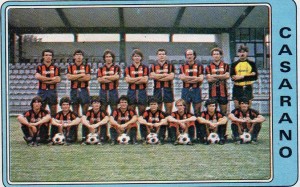
Casarano – 9th with 32 points.
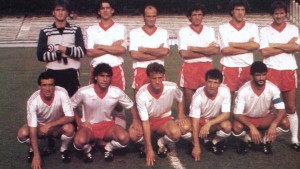
Campania – 8th with 32 points.
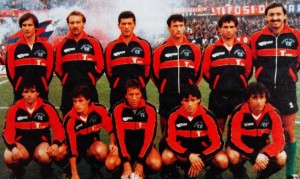
Cosenza – 7th with 37 points.

Casertana – 6th with 37 points.
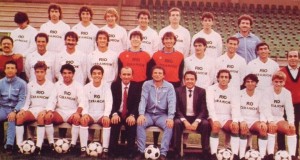
Monopoli – 5th with 37 points.
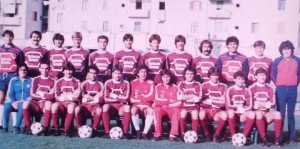
Salernitana – 4th with 38 points.
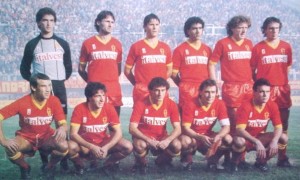
Messina – 3rd with 42 points.

Palermo – 2nd with 45 points. Lost first place on goal-difference, but promoted, so no worry.
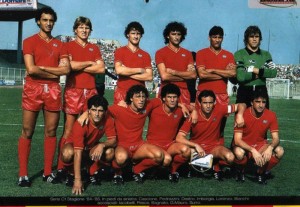
Catanzaro – champions of Girone B and promoted. Better goal-difference than Palermo’s did it, but no matter. 17 wins, 11 ties, 6 losses, 54-30, 45 points.
Italy III Division Group A
Third Division – Serie C/1. Two groups of 18 teams each, the top 2 promoted, the last 4 – relegated. In case of equal points, all depended on table positions – if promotion was at stake, a play-off was staged. If relegation was at stake – head-to-head results decided. Some familiar names pop up here.
Girone A. Old habits – so difficult to change: two teams amassed 20 ties in the 34-rounds championship.
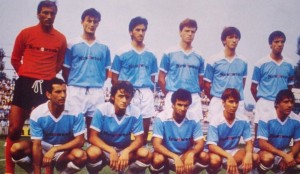
Treviso – last with 22 points. And out.
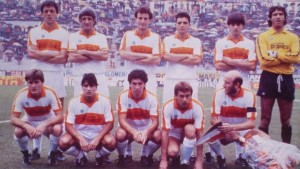
Pistoiese – 17th with 27 points. Relegated.
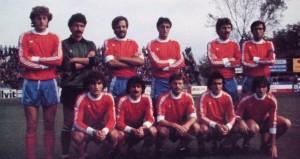
Asti T.S.C. – 16th with 27 points. Out.
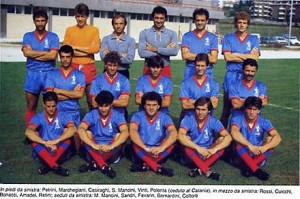
Jesi – 15th with 30 points. Unlucky and may be rules were unfair in situation like this: they were relegated instead of SPAL, because SPAL had better head-to-head record against them. Yet, both teams finished not only with equal points, but with equal goal-difference: -10.
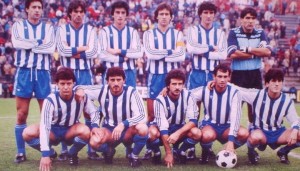
SPAL – lucky survivors: 14th with 30 points.
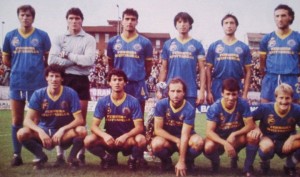
Carrarese – 13th with 31 points.

Sanremese – 12th with 32 points.
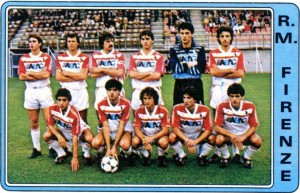
R.M. Firenze – 11th with 32 points.

Pavia – 10th with 32 points.
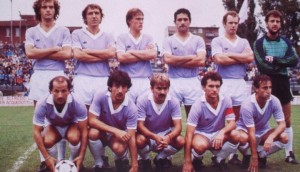
Legnano – 9th with 32 points.
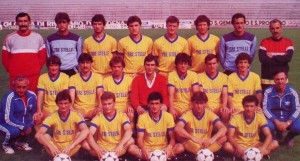
Modena – 8th with 33 points.
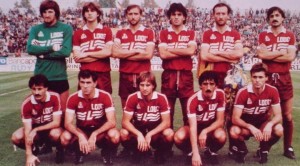
Livorno – 7th with 35 points.

Ancona – 6th with 35 points.
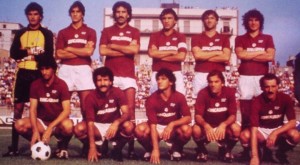
Reggiana – 5th with 36 points.
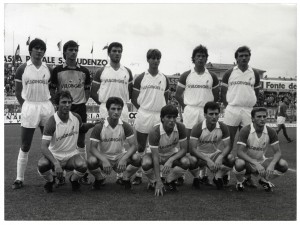
Rimini – 4th with 40 points. Rimini stood above most of the league, but failed to reach the leaders – three teams competed for 2 promotional spots and it went to post-season play off.
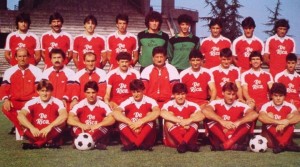
Piacenza was unlucky and ended 3rd. Same points and even same record as Vicenza, only worse goal-difference, but this did not count. In the play-off Piacenza lost in overtime 1-3.
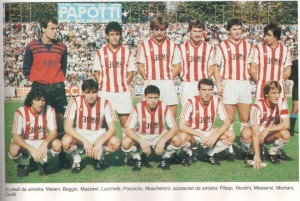
Thanks to the play-off, L.R. Vicenza clinched 2nd place and promotion. Successful season for one Roberto Baggio, still unknown to the public at large.
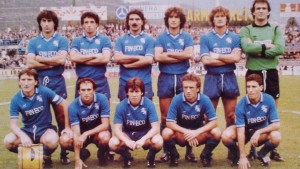
Brescia won the championship with 48 points. 15 wins, 18 ties, only a single loss, 47-18 goal-difference. It was not overwhelming victory – just 3 points ahead of Vicenza and Piacenza – but it was important to climb up and that was achieved. Like Vicenza, Brescia was not a club to play 3rd level football.
Italy IV Division Groups C & D
Serie C/2 – continued.
Girone C.
Cattolica – 18th with 13 points. The weakest team in the whole 4th Division.
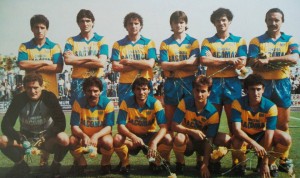
Fermana – 17th with 27 points. Relegated.
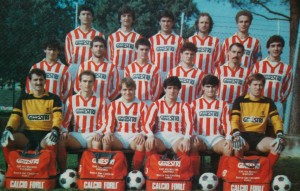
Forli – 16th with 28 points. Relegated.
Cesenatico – 15th with 30 points.
Vigor Senigallia – 14th with 31 points.
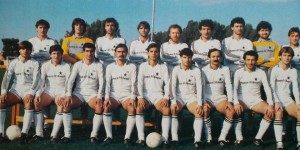
Galatina P.I. – 13th with 31 points.
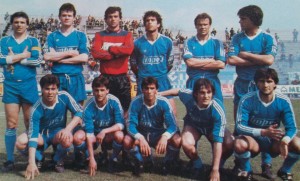
Matera – 12th with 32 points.
Giulianova – 11th with 33 points.
Maceratese – 10th with 34 points.
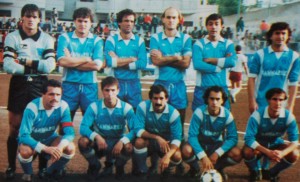
Martina – 9th with 34 points.
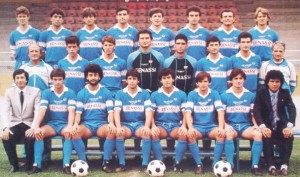
Centese – 8th with 35 points.
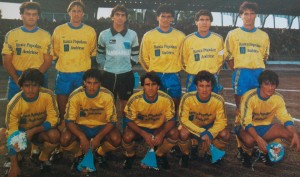
Fidelis Andria – 7th with 36 points.
Sassuolo – 6th with 36 points.
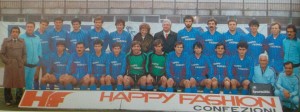
Foligno – 5th with 41 points.
Strange or not, but the next 3 teams went to promotional play-off – they all finished with 42 points and almost the same goal-difference: Teramo and Civitanovese with +11 and Fano with +9. Similar problem was solved differently in Girone A, but here – play-offs. They decided nothing, except the elimination of Teramo. Fano and Civitanovese proceeded to a final, played in Perugia. Regular and extra time ended 0-0. In the penalty shoot-out Fano prevailed 6-5. Great luck or what?
Teramo 4th with 42 points.
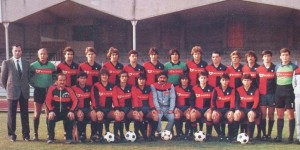
Civitanovese – 3rd with 42 points.
Fano – 2nd with 42 points and promoted.
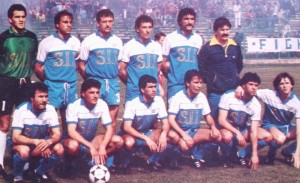
Brindisi – group champions with 45 points and promoted.
Girone D.
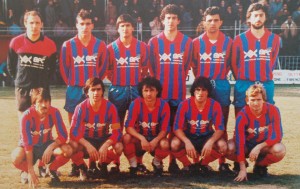
Crotone – last with 27 points and relegated.
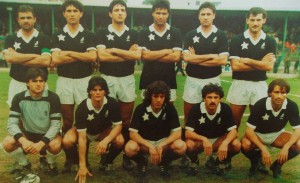
Frattese – 17th with 29 points. Relegated.

Alcamo – 16th with 29 points and relegated.
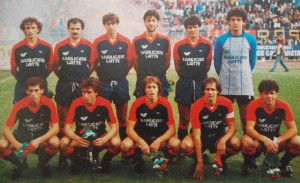
Potenza – 15th with 30 points.

Canicatti – 14th with 30 points. Canicatti had 5 points deducted for some infringement, but was not in danger of relegation.
Aesernia – 13th with 31 points.
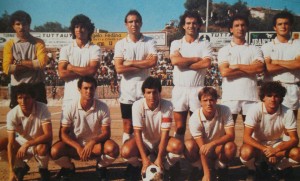
Nissa – 12th with 31 points.
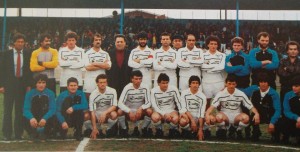
Gladiator – 11th with 31 points.
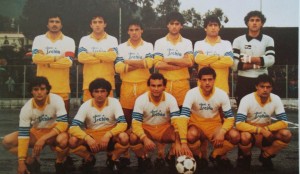
Ischia Isolaverde – 10th with 31 points.
Ercolanese – 9th with 33 points.
Paganese – 8th with 33 points.

Rende – 7th with 34 points.
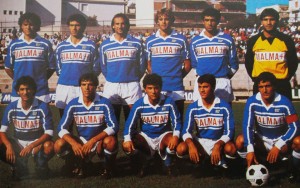
Siracusa – 6th with 34 points.
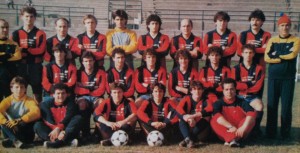
Afragolese – 5th with 34 points.
Turris – 4th with 41 points.
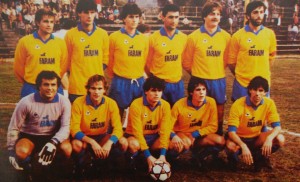
Frosinone – 3rd with 42 points. Familiar name? Not back then.
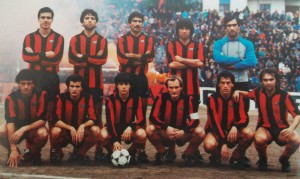
Sorrento – clinched 2nd place with 43 points and promoted.
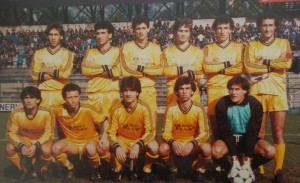
Licata – group champion with 44 points. Promoted, of course.
Italy IV Division Groups A & B
Italy. Suffice to say who played in Italy this season: Michel Platini (Fra) and Zbigniew Boniek (Pol) – Juventus; Falcao and Toninho Cerezo (Bra) – Roma; Daniel Passarella (Arg) and Socrates (Bra) – Fiorentina; Diego Maradona and Daniel Bertoni (Arg) – Napoli; Graeme Souness (Sco) and Trevor Francis (Eng) – Sampdoria; Ray Wilkins and Mark Hateley (Eng) – Milan; Edinho and Zico (Bra) – Udinese; Hansi Muller (BRD) and Dan Cornesiusson (Swe) – Como; Hans-Peter Briegel (BRD) and Preben Ekjaer-Larsen (Den) – Verona; Ludo Coeck (Bel), Dirceu (Bra), Patricio Hernandez (Arg) and Aleksandar Trifunovic (Yug) – Ascoli; Junior (Bra) and Walter Schachner (Aus) – Torino; Geronimo Barbadillo (Peru) and Ramon Diaz (Arg) – Avellino; Batista (Bra) and Michael Laudrup (Den) – Lazio; Glenn Stromberg and Lasse Larsson (Swe) – Atalanta; Julio Uribe (Peru) – Bologna; Jan Peters (Hol) and Eloi (Bra) – Genoa; Wladyslaw Zmuda (Pol) and Juary (Bra) – Cremonese; Klaus Berggreen (Den) and Wim Kift (Hol) – Pisa; Luvanor and Pedrinho (Bra) – Catania. Let add some ‘exotic’ names too: Silvano Martina (Bosna and Herzegovina) – Torino; Richard Mapuata (Switzerland) – Lazio; Massimo Bonini (San Marino) – Juventus; Marco Macina (San Marino) -Parma; Daniele Zoratto (Luxembourg) – Brescia; Enzo Concina (Canada) – Cesena. The top championship of the whole world, even without mentioning Italian stars! Of course, invisible from the lower levels of Italian football.
Forth Division – Serie C/2. 4 groups of 18 teams each, the top 2 promoted and the lowest 3 relegated. Girone A:
Imperia – 18th with 29 points. Relegated.
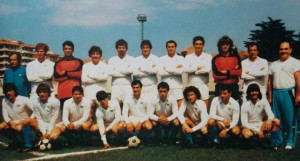
Nuorese – 17th with 29 points. Relegated.
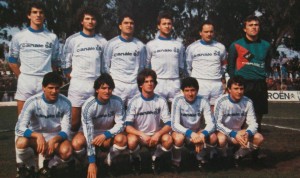
Olbia – 16th with 29 points. Relegated.
Vogherese – 15th with 29 points.
Carbonia – 14th with 29 points.
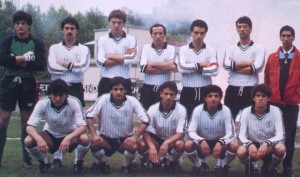
Spezia – 13th with 29 points.
Civitavecchia – 12th with 31 points.
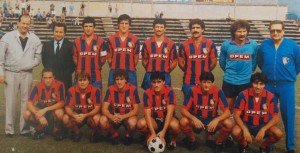
Montevarchi – 11th with 31 points.

Savona – 10th with 31 points.
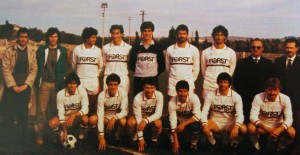
Torres – 9th with 32 points.

Massese – 8th with 33 points.
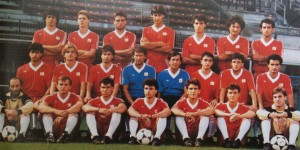
Lodigiani – 7th with 35 points.
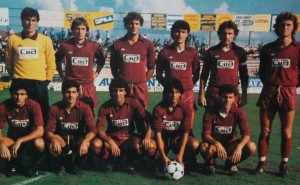
Pontedera – 6th with 39 points.
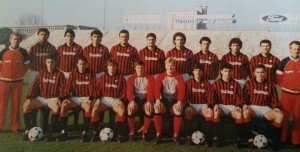
Lucchese – 5th with 39 points.
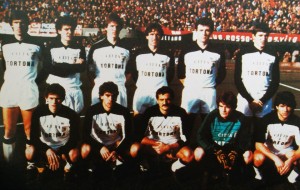
Derthona – 4th with 39 points.
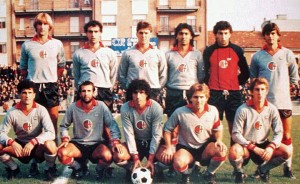
Alessandria – 3rd with 42 points. Unlucky – lost promotion not even on goal-difference, but only because scored 1 goal less than the rivals. That is, the same happened in the play-off against Prato – 2-3.
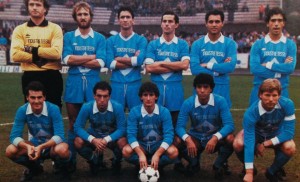
Prato – 2nd with 42 points. Lucky – even their goal-difference matched Alessandria’s, but they scored 45 goals to Alessandria’s 44. The only team without a lost match at home, but this one goal… they won the play-off against Alessandria 3-2.
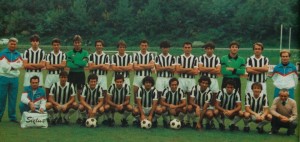
Siena – champions of the group with 44 points. Promoted.
Girone B.
Mira – 18th Relegated.

Gorizia – 17th with 19 points. Relegated.
Rhodense – 16th with 23 points. Relegated.
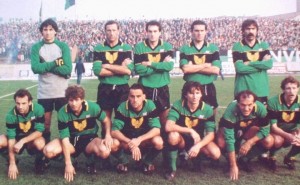
Venezia – 15th with 31 points.
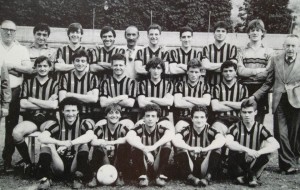
Omegna – 14th with 32 points.
Pro Patria – 13th with 33 points.
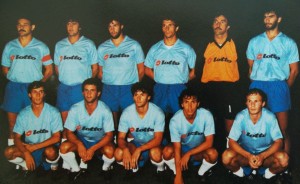
Montebelluna – 12th with 34 points.
Mestre – 11th with 35 points.
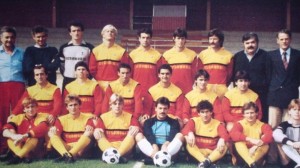
Pievigina – 10th with 35 points.
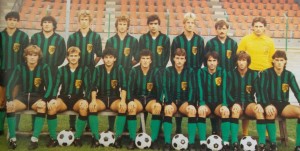
Pordenone – 9th with 35 points.
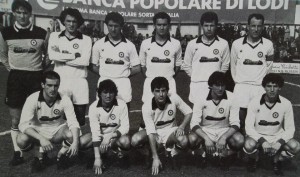
Fanfulla – 8th with 35 points.
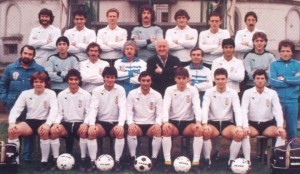
Pro Vercelli – 7th with 36 points.
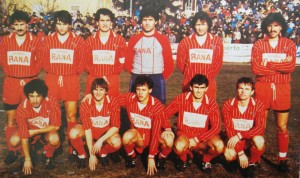
Mantova – 6th with 36 points.

Novara – 5th with 38 points.
Pergocrema – 4th with 39 points.

Ospitaletto – 3rd with 44 point. Lost promotion after tough play-off against Trento (0-0 after overtime and 4-5 in the penalty shoot-out) and amusingly low scoring team: only 29 goals in 34 games.
Trento – 2nd with 44 points. Lucky – clinched promotion after play-off.

Virascit Boccaleone – group champions with 45 points. Tough battle with strong opposition, so the victory was sweeter. Promoted, of course.
West Germany the Cup
The Cup final opposed mighty Bayern to Bayer Uerdingen. For all its good form, Bayer was nothing compared to the giant, and the final was predictable: Bayer will put the good fight, but Bayern will enjoy a double. Hoeness scored in the 8th minute and everything seemed finished, fulfilling the prediction. Feilzer equalized right away, in the 9th minute, but so what? Bayern will score again – after all, Hoeness and company were not almost anonymous guys like Feilzer. He may have scored, but a second one? Now, Bayern scored and scored goals. Second goal arrived, of course, but in the second half and the scorer was neither Hoeness, nor Rummenigge Junior. Schaffer scored for Bayer in the 66th minute and to the end of the game Bayern was unable to equalize. No double.

Rather modest squad delightfully triumphed.
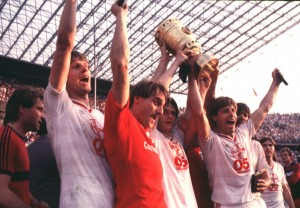
The Cup was theirs – what joy!
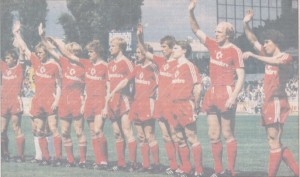
Bayern lost the final and the double, which was not a happy moment for them. This is not the team which played at the Cup final – from left to right: Augenthaler, Pfaff (practically hidden), Willmer, Lerby, Wohlfarth, Pflugler, Durnberger, Eder, Kogl, Dieter Hoeness, Mathaus. It could have been a mistake made because of the obvious superiority Bayern had over all others: with squad so deep and strong, looked like that Lattek varied the starting eleven, often mixing 2-3 reserve players with the regulars. The approach, although plausible, is also risky – it may misfire on occasion. It builds too much comfort, the team may get a bit lazy and self-assured: after all, we beat everybody even with reserves. To a point, the prize for over-comfidence was paid at the Cup final: no matter what, Bayern was facing a German opponent and German teams at least match Bayern in physicality and fighting spirit.
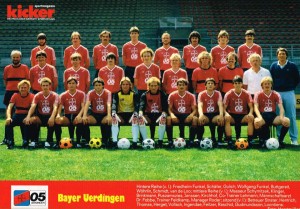
Great victory of the underdog! Bayer had their best year ever, crowned with winning the Cup. Feldkamp coached them excellently, but as a squad, it was a modest one. Herget, Schafer, the Icelandic import Gudmundsson… not much and understandable so: Bayer, after all, was not a big club with tons of money. They were still the better ‘Aspirins’, but whatever money the pharmaceutical giant invested in football was split between their two clubs and already looked like Leverkusen was going to be the first choice of the sponsor. Thus, the victory was priceless – against any odds, even against corporate policy, if you wish. Beating Bayern in itself may endear many to the winners. And for clubs of the caliber of Uerdingen a win is particularly cherished, for both club and supporters know down in theit hearts that success can be only occasional, most likely never to be repeated. Lovely moment.

A moment deserving to be repeated – as it was, for the photo is not from the Cup final, but a bit later – a proud display for the fans. And not only.
West Germany I Division
The Bundesliga. Hardly a memorable season – Bayern was the only solid team. The rest betrayed various problems – problems of West German football in general. The pool of talent was seemingly smaller than before, no foreigners of big quality were coming, German stars leaving to play in lucrative Italy. Perhaps the international failure of VfB Stuttgart was the best diagnosis: it its peak, the club made no impact on European football. Of course, the championship was competitive and tough, but the level was lower and the direction was downwards.

Eintracht Braunschweig was one of the two outsiders this season and finished last with 20 points. Not a big surprise, given the club’s tradition.
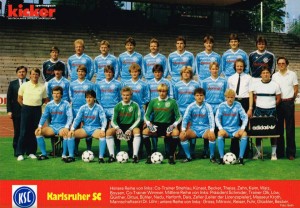
Karlsruher SC – the second outsider. 17th with 22 points. Along with Braunschweig, directly relegated.
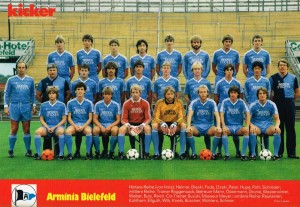
Arminia Bielefeld – 16th with 29 points. As usual, struggling to stay in the league and not succeeding. Lost safety on goal-difference – unfortunate, but not the end of the world yet. Losing the promotion/relegation play-off against the 3rd place in Second Division, 1.FC Saarbrucken was the painfully familiar end: once again down to second level football. Curious note: they had Japanese co-trainer this year. Something very exotic and as far as coaching goes… practically unique for an European club. The Japanese player Ozaki was not a news – his presence only showed increasing class of Japanese players.
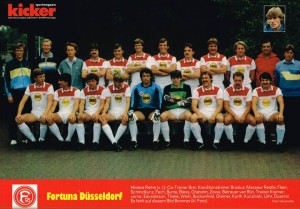
Fortuna Dusseldorf – in obvious decline and only lucky to escape the rick of relegation on better goal-difference: 15th with 29 points.
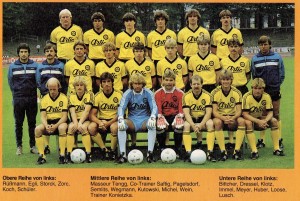
Borussia Dortmund – 14th with 30 points. Only 2 or 3 years ago Borussia was seen as ascending team, possibly going to the top. Instead, it went the opposite direction and looking at the squad the reasons for the plunge are quite obvious: Russmann, Zorc, Egli, Storck were getting only older ann naturally fading. Immel was the only player with star potential and going up.
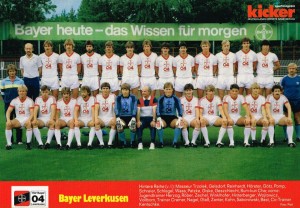
Bayer Leverkusen – 13th with 31 points. Nothing special, but nobody expected much of them – Bayer was still a suspect newcomer, perhaps happy to play a few seasons in the top division, before sinking back to obscurity. The club surely had different ideas, but they were following them rather quietly and methodically. Very good coach, few decent – but not outstanding – players, hard work. Still among the weaker teams, but keeping place in the league.

Eintracht Frankfurt – another club in decline. 12th with 32 points. Compared to the squad of 10 years ago, the current one was pitiful. Only one thing worthy of mentioning: Korbel. The sturdy defender was becoming something like eternal feature of Bundesliga.
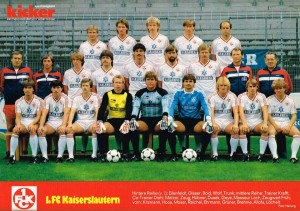
1.FC Kaiserslautern – 11th with 33 points. Traditionally, they fluctuated widely, so low position this season fitted the pattern.
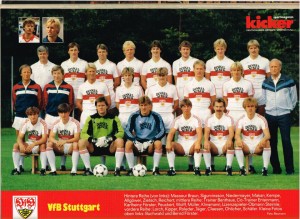
VfB Stuttgart – a big disappointment: 10th with 33 points. Not only they were at the top just a few months earlier, but this was the only squad at the moment pretty equal to Bayern’s. Such players and nothing…
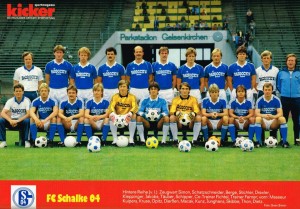
Schalke 04 – 9th with 34 points. Hard to tell – the squad was not much, but Schalke was coming back from a crisis, so one cannot expect some awesome team. Compared to Stuttgart, this team was poorly, yet, they finished ahead of Stuttgart.
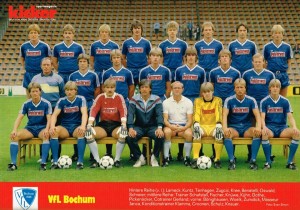
VfL Bochum – 8th with 34 points. The great survivors – modest squad as ever, but playing with heart and soul and doing just fine as a result.

Bayer Uerdingen – 7th with 36 points. Their finest season ever, so more about them later.
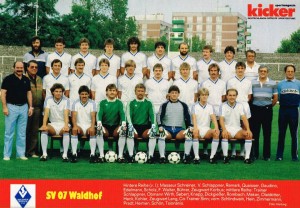
SV 07 Waldhof Mannheim – 6th with 37 points. Arguably, having their best season in history, but hardly anybody was fooled: it was one-time performance. The squad was nothing to speak of and the club was modest, so whatever better players they had (Gaudino and Walter) most likely would go elsewhere.
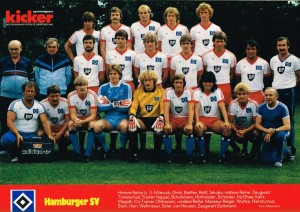
Hamburger SV – 5th with 37 points. The beat the accidental Waldhof only on goal-difference was quite telling: HSV already reached its peak and now was slowly going down. It was enraging to see such team unable to compete for the title – may be they were a bit weaker than Stuttgart, but must have been rubbing shoulders with Bayern, not Waldhof. Not so terrible season as Stuttgart’s, but on slippery sloap nevertheless, giving the distinct feeling that there was no climbing back to top. Short-lived greatness.
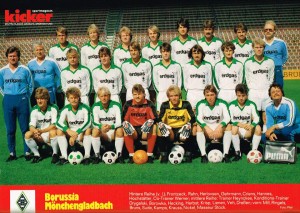
Borussia Moenchengladbach – 4th with 39 points. Their great years were over, that was clear for some time already, but Borussia was hanging on – ate least their fading away was not going to be rapid and drastic. They were also the club easily excused: everybody knew they were always short of money and to have decent squad was nothing but a miracle even in their greatest years. They still managed to keep a number of good players against the odds, but perhaps the most important reason for staying relatively strong was their new coach – Heynckes was rapidly transforming from great player into great coach. Borussia was not to be dismissed yet.
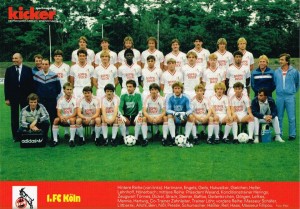
1.FC Koln – 3rd with 40 points. For some reason this club was unable to built on their now distant title in the late 1980s. The potential was there, but they, although keeping among the best, remained unfulfilled promise. Why Koln never really happened is a question without meaningful answer: may be wrong recruiting policy. The current team was very similar to their champion team – good, but short of great and in need of few strong additions. This need was not solved after winning the title, nor in the following years, and it was surely not going to be solved now. Koln somehow remained a decent, but unfinished team – hence, 3rd, but distant 3rd.
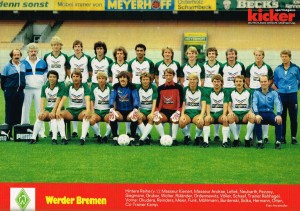
Werder – 2nd with 46 points. The shameful exile in Second Division was already fading memory, now Werder was enjoying one of their sudden and not lived strong periods. Frankly, even with Voller, already singled out as rapidly becoming a superstar, Werder was not equal to Stuttgart and Hamburger. Not even to Koln. Pezzey and Okudera were aging, the rest were just capable second-raters. Good team, but hardly a title contender – and they were not, Bayern easily left them in the dust. But Werder left far behind Koln and HSV and Stuttgart were nowhere to be seen. Hats off to Otto Rehhagel.
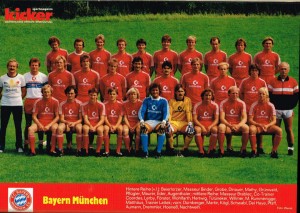
Bayern – one more title, apparently, easily won. 21 wins, 8 ties, 5 losses, 79-38, 50 points. Werder was left 4 points behind, the others did not even count. The only trouble was that it was always Bayern… in the 1970s the great rivalry with Borussia Moenchengldabach kept the intrigue, but now it was only Bayern. Cannot blame them – this was the only European-class squad, well rounded and deep, coached by still excellent Lattek.
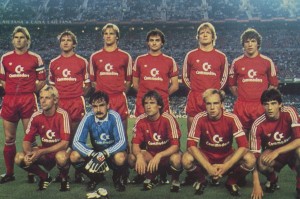
Bayern had the luxury to field a team like this one: top, left to right: Klaus Aughentaler, Wolfgang Dremmler, Hans Pfleugler, Bernd Martin, Soren Lerby, Lothar Matthaus. Bottom, left to right: Norbert Nachtweith, Raimond Aumann, Norbert Eder, Michael Rummenigge, Reinhold Mathy. Or some other version, just as strong. It was a club on entirely different level, compared to the other West German clubs. And that suggested only one thing – West German football was going to be dominated by one club. Too bad for the game.
Germany II Division
West Germany. This championship lost quite a lot of its edge – there were more teams in decline and there were those which had short lived prominence, contrary to expectation. More or less, the West German football became one-team show. Nothing like the glorious 1970s. Top players were going to Italy and no big international talent was coming.
Second Division. 20 teams, the last 4 relegated, the top 2 directly promoted and the 3rd going to promotion/relegation play-off against the 16th in the Bundesliga. One outsider this season, 4 teams competing for promotion.
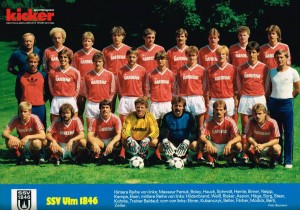
SSV Ulm 1846 was the outsider – last with 22 points, winning only 5 games.

Kickers Offenbach – 19th with 32 points. Unclear why they were placed 19th, since they finished with more points than the 18th.
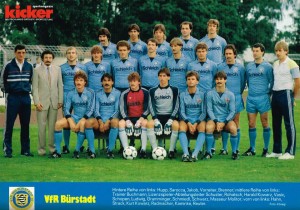
VfR 1910 Burstadt – 18th with 31 points. Newly promoted, they were relegated immediately.
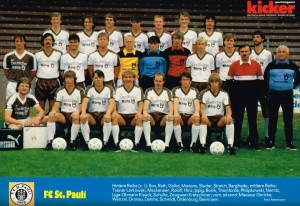
FC St. Pauli – 17th with 33 points. Like Burstadt, just promoted and going back to third level right away.
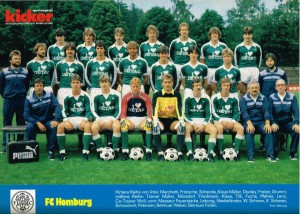
FC 08 Homburg – lucky 16th with 34 points. Also just promoted and barely avoiding relegation.
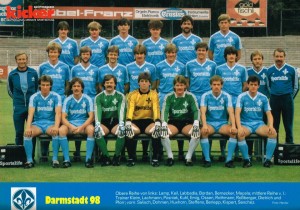
Darmstadt 98 – 15th with 35 points. Another lucky escape.
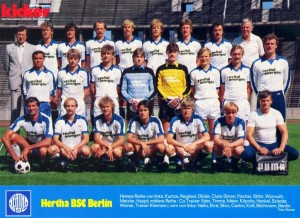
Hertha BSC – 14th with 35 points. Their misery continued – just lucky to avoid relegation.
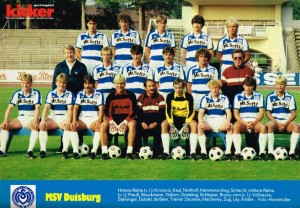
MSV Duisburg – 13th with 35 points. Like Hertha, fighting for dear life and grateful for escaping the Regional leagues.
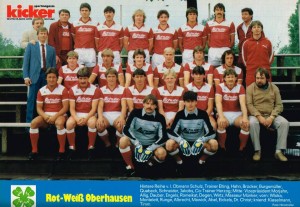
Rot-Weiss Oberhausen – 12th with 35 points. One more team struggling to stay in the league. Perhaps even their fans forgot that Rot-Weiss played top league football once upon a time.
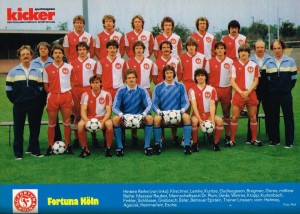
Fortuna Koln – 11th with 36 points. A bit weaker than usual, but second division was truly their environment, so they were not seen as declining.
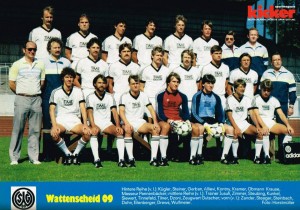
SG Wattenscheid 09 – 10th with 36 points. Like Fortuna, a bit weaker than usual, but no big deal.
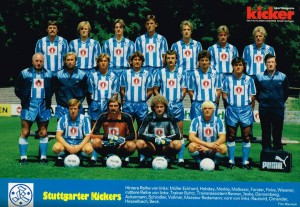
Stuttgarter Kickers – 9th with 37 points. One more typical second division team, performing accordingly: neither too strong, nor too weak.
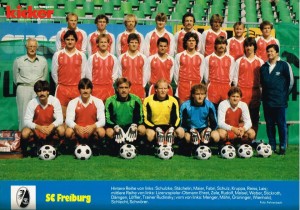
SC Freiburg – 8th with 38 points.
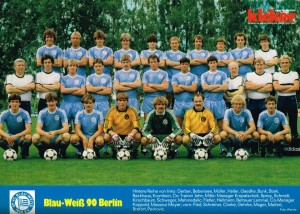
Blau-Weiss 90 Berlin – the best of the newly promoted teams: 7th with 39 points. However, it did look like a season fueled by enthusiasm and unlikely to be repeated.
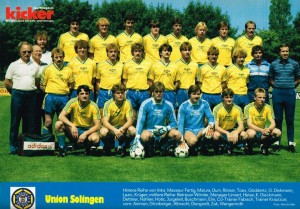
SG Union Solingen – 6th with 41 points. Strong season, but hardly suggesting anything more than just occasional good year.
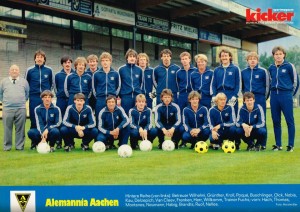
Alemannia Aachen – 5th with 43 points. Their usual – quite remote from promotional ambitions.
That was the bulk of the league, separated clearly from the top 4 teams. They fought for promotion and one team had to be out. Fierce race – 1 point was the whole difference, the unlucky 4th losing on goal-difference.
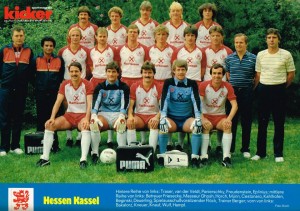
KSV Hessen Kassel – what a misfortune: 4th with 49 points. Weaker goal-difference worked against them and that was only too bad, for Hessen had modest existence, practically never aiming at promotional spot and quite unlikely to repeat their strong season.
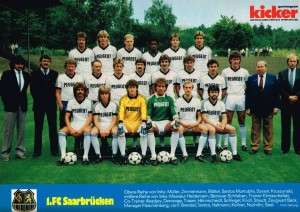
1. FC Saarbrucken – lucky to finish 3rd. 49 points and better goal-difference than Hessen gave them a chance for promotion. They did not miss their chance, beating Arminia (Bielefeld) in the play-off and climbing up for one more try of top flight football. The team was not very promising, so it was going to be a very hard task, but at least this season ended on high note. Perhaps this was the highest achievement of the former Bulgarian star Abadjiev, who was one of their coaches.
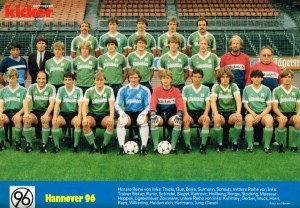 Hannover 96 clinched direct promotion, ending with 50 points. Lost first place on goal-difference, but promotion mattered most. Well, up and down, up and down – that was there history. Now it was up. Staying in First Division was another matter.
Hannover 96 clinched direct promotion, ending with 50 points. Lost first place on goal-difference, but promotion mattered most. Well, up and down, up and down – that was there history. Now it was up. Staying in First Division was another matter.
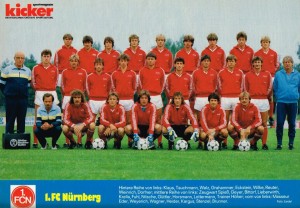
1.FC Nurnberg – 50 points and better goal-difference made them champions of Second Division. Lucky to win the 4-team battle, but they were not promising squad either. 23 wins, 4 ties, 11 losses, 71-45 goal-difference – not a very impressive record for a champion. Like Hannover 96, they were doomed to meandering between 1st and 2nd divisions. It was great to go up again, but… neither of the three promoted teams looked like it will make some impact in the highest league. est Germany. This championship lost quite a lot of its edge – there were more teams in decline and
